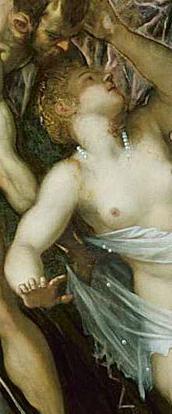 This is a detail of Tintoretto’s “Tarquin and Lucretia” (1578-1580), which belongs to the Art Institute of Chicago but is now in Boston for the astounding exhibition entitled “Titian, Tintoretto, Veronese: Rivals in Renaissance Venice.” (Probably never before have so many comparable paintings by these competitors been hung together.)
This is a detail of Tintoretto’s “Tarquin and Lucretia” (1578-1580), which belongs to the Art Institute of Chicago but is now in Boston for the astounding exhibition entitled “Titian, Tintoretto, Veronese: Rivals in Renaissance Venice.” (Probably never before have so many comparable paintings by these competitors been hung together.)
In the detail, pearls are strewn across Lucretia’s clothes; Tarquin has just broken the strand. The spheres are caught on their way downward, spaced at growing intervals.
People have always known that objects move, and have always depicted motion in still images–since the ancient cave paintings. But I think Tintoretto’s painting may reflect a new way of thinking about motion and space. The image represents a precise instant at which each pearl would occupy a different and predictable location because of the mathematical laws of nature. The objects are frozen, but their locations allow us to infer their movement.
Galileo revolutionized science by claiming that nature was a book written in the language of mathematics. Tintoretto painted Galileo’s portrait from life in 1605-7, which shows that the two geniuses knew each other. By 1638, Galileo had proved (either in a real experiment on the Tower of Pisa, or in a thought-experiment) that objects of different weights would fall at the same accelerating rate. And forty years later, Tintoretto was interested enough in this Galilean conception of time and space that he painted pearls accelerating down Lucretia’s chest. It was another thought-experiment.
In Tiepolo’s “St. Dominic Instituting the Rosary” (1737-9), the rosary itself plummets at high speed from an enormous sky painted on the ceiling of the Gesuati Church in Venice. That is an excellent example of baroque theatricality, but not a unique one. By then, Europeans automatically thought of motion in Galilean terms. Tintoretto was perhaps the first to paint that way.
From Bob Atwan, via email:
Dear Peter Levine- I thought that was a wonderful observation about the falling pearls. I just saw the work at the MFA yesterday (Wed/April 1) and had a similar thought–I couldn’t recall that sort of movement in an earlier painting. But every time I think such a thing I find there’s an earlier moment.
Those falling pearls arrested me–they stood for so many things at once.
Not an art historian or theorist, just an interested observer.